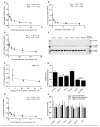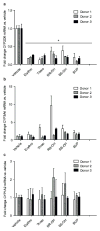In vitro to in vivo extrapolation of the complex drug-drug interaction of bupropion and its metabolites with CYP2D6; simultaneous reversible inhibition and CYP2D6 downregulation
- PMID: 27836670
- PMCID: PMC5164944
- DOI: 10.1016/j.bcp.2016.11.007
In vitro to in vivo extrapolation of the complex drug-drug interaction of bupropion and its metabolites with CYP2D6; simultaneous reversible inhibition and CYP2D6 downregulation
Erratum in
-
Corrigendum to "In vitro to in vivo extrapolation of the complex drug-drug interaction of bupropion and its metabolites with CYP2D6; simultaneous reversible inhibition and CYP2D6 downregulation" [Biochem. Pharmacol. 123(2017)85-96].Biochem Pharmacol. 2021 Jan;183:114306. doi: 10.1016/j.bcp.2020.114306. Epub 2020 Nov 5. Biochem Pharmacol. 2021. PMID: 33161206 Free PMC article. No abstract available.
Abstract
Bupropion is a widely used antidepressant and smoking cessation aid and a strong inhibitor of CYP2D6 in vivo. Bupropion is administered as a racemic mixture of R- and S-bupropion and has stereoselective pharmacokinetics. Four primary metabolites of bupropion, threo- and erythro-hydrobupropion and R,R- and S,S-OH-bupropion, circulate at higher concentrations than the parent drug and are believed to contribute to the efficacy and side effects of bupropion as well as to the CYP2D6 inhibition. However, bupropion and its metabolites are only weak inhibitors of CYP2D6 in vitro, and the magnitude of the in vivo drug-drug interactions (DDI) caused by bupropion cannot be explained by the in vitro data even when CYP2D6 inhibition by the metabolites is accounted for. The aim of this study was to quantitatively explain the in vivo CYP2D6 DDI magnitude by in vitro DDI data. Bupropion and its metabolites were found to inhibit CYP2D6 stereoselectively with up to 10-fold difference in inhibition potency between enantiomers. However, the reversible inhibition or active uptake into hepatocytes did not explain the in vivo DDIs. In HepG2 cells and in plated human hepatocytes bupropion and its metabolites were found to significantly downregulate CYP2D6 mRNA in a concentration dependent manner. The in vivo DDI was quantitatively predicted by significant down-regulation of CYP2D6 mRNA and reversible inhibition of CYP2D6 by bupropion and its metabolites. This study is the first example of a clinical DDI resulting from CYP down-regulation and first demonstration of a CYP2D6 interaction resulting from transcriptional regulation.
Keywords: Bupropion; CYP2D6; Drug-drug interactions; Enzyme regulation; In vitro to in vivo extrapolation.
Copyright © 2016 Elsevier Inc. All rights reserved.
Conflict of interest statement
None of the authors have any conflicts of interest with the current work.
Figures





Similar articles
-
The strong clinical interaction between bupropion and CYP2D6 is primarily mediated through bupropion metabolites and their stereoisomers: A paradigm for evaluating metabolites in drug-drug interaction risk.Drug Metab Dispos. 2025 May;53(5):100070. doi: 10.1016/j.dmd.2025.100070. Epub 2025 Mar 24. Drug Metab Dispos. 2025. PMID: 40245579
-
Stereoselective Metabolism of Bupropion to Active Metabolites in Cellular Fractions of Human Liver and Intestine.Drug Metab Dispos. 2023 Jan;51(1):54-66. doi: 10.1124/dmd.122.000867. Epub 2022 May 5. Drug Metab Dispos. 2023. PMID: 35512805 Free PMC article.
-
Stereoselective Glucuronidation of Bupropion Metabolites In Vitro and In Vivo.Drug Metab Dispos. 2016 Apr;44(4):544-53. doi: 10.1124/dmd.115.068908. Epub 2016 Jan 22. Drug Metab Dispos. 2016. PMID: 26802129 Free PMC article. Clinical Trial.
-
Chirality and neuropsychiatric drugs: an update on stereoselective disposition and clinical pharmacokinetics of bupropion.Xenobiotica. 2018 Sep;48(9):945-957. doi: 10.1080/00498254.2017.1376765. Epub 2017 Oct 13. Xenobiotica. 2018. PMID: 28876959 Review.
-
System-dependent outcomes during the evaluation of drug candidates as inhibitors of cytochrome P450 (CYP) and uridine diphosphate glucuronosyltransferase (UGT) enzymes: human hepatocytes versus liver microsomes versus recombinant enzymes.Drug Metab Pharmacokinet. 2010;25(1):16-27. doi: 10.2133/dmpk.25.16. Drug Metab Pharmacokinet. 2010. PMID: 20208386 Review.
Cited by
-
Metabolomic Analysis Demonstrates the Impacts of Polyketide Synthases PKS14 and PKS15 on the Production of Beauvericins, Bassianolide, Enniatin A, and Ferricrocin in Entomopathogen Beauveria bassiana.Metabolites. 2023 Mar 14;13(3):425. doi: 10.3390/metabo13030425. Metabolites. 2023. PMID: 36984865 Free PMC article.
-
Isotretinoin and its Metabolites Alter mRNA of Multiple Enzyme and Transporter Genes In Vitro, but Downregulation of Organic Anion Transporting Polypeptide Does Not Translate to the Clinic.Drug Metab Dispos. 2022 Jul;50(7):1042-1052. doi: 10.1124/dmd.122.000882. Epub 2022 May 11. Drug Metab Dispos. 2022. PMID: 35545255 Free PMC article.
-
Physiologically-Based Pharmacokinetic Modeling for the Prediction of CYP2D6-Mediated Gene-Drug-Drug Interactions.CPT Pharmacometrics Syst Pharmacol. 2019 Aug;8(8):567-576. doi: 10.1002/psp4.12411. Epub 2019 Jul 3. CPT Pharmacometrics Syst Pharmacol. 2019. PMID: 31268632 Free PMC article.
-
Do Inhibitory Metabolites Impact DDI Risk Assessment? Analysis of in vitro and in vivo Data from NDA Reviews Between 2013 and 2018.Clin Pharmacol Ther. 2021 Aug;110(2):452-463. doi: 10.1002/cpt.2259. Epub 2021 May 8. Clin Pharmacol Ther. 2021. PMID: 33835478 Free PMC article.
-
Influence of CYP2B6 Pharmacogenetics on Stereoselective Inhibition and Induction of Bupropion Metabolism by Efavirenz in Healthy Volunteers.J Pharmacol Exp Ther. 2022 Jul 7;382(3):313-26. doi: 10.1124/jpet.122.001277. J Pharmacol Exp Ther. 2022. PMID: 35798386 Free PMC article.
References
-
- Bohnert T, Patel A, Templeton I, Chen Y, Lu C, Lai G, Leung L, Tse S, Einolf HJ, Wang YH, Sinz M, Stearns R, Walsky R, Geng W, Sudsakorn S, He L, Wahlstrom J, Keirns J, Narayanan R, Lang D, Yang X. Evaluation of a New Molecular Entity as a Victim of Metabolic Drug-Drug Interactions - an Industry Perspective. Drug Metab Dispos. 2016 doi: 10.1124/dmd.115.069096. - DOI - PubMed
-
- Vieira MLT, Kirby B, Ragueneau-Majlessi I, Galetin A, Chien JYL, Einolf HJ, Fahmi OA, Fischer V, Fretland A, Grime K, Hall SD, Higgs R, Plowchalk D, Riley R, Seibert E, Skordos K, Snoeys J, Venkatakrishnan K, Waterhouse T, Obach RS, Berglund EG, Zhang L, Zhao P, Reynolds KS, Huang S-M. Evaluation of various static in vitro-in vivo extrapolation models for risk assessment of the CYP3A inhibition potential of an investigational drug. Clin Pharmacol Ther. 2014;95:189–98. doi: 10.1038/clpt.2013.187. - DOI - PubMed
-
- Grimm SW, Einolf HJ, Hall SD, He K, Lim H-K, Ling K-HJ, Lu C, Nomeir AA, Seibert E, Skordos KW, Tonn GR, Van Horn R, Wang RW, Wong YN, Yang TJ, Obach RS. The Conduct of in Vitro Studies to Address Time-Dependent Inhibition of Drug-Metabolizing Enzymes: A Perspective of the Pharmaceutical Research and Manufacturers of America. Drug Metab Dispos. 2009;37:1355–1370. doi: 10.1124/dmd.109.026716. - DOI - PubMed
MeSH terms
Substances
Grants and funding
LinkOut - more resources
Full Text Sources
Other Literature Sources

